Soviet Tanks and Armored Fighting Vehicles 1947- Today
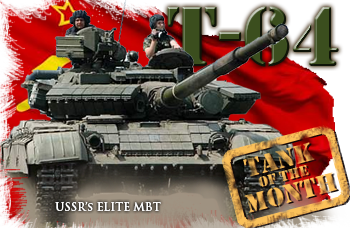 Soviet Union - circa 250,000 AFVs
Soviet Union - circa 250,000 AFVs
Situation in 1945.
In 1945, the Red army seemed unstoppable. With almost twice the numbers of soldiers and armored vehicles than the Allies, some of the top staff officers realized how easy it could have been to not stop half way but just run to the sea with such a massive and well-oiled war machine, fulfilling the promised "world proletarian revolution" prophesized by Lenin. Both sides were indeed well aware of what was seen largely as an uneasy alliance, dictated by circumstances, and after the end of hostilities, peace negotiations with Stalin proved to be especially tough.The West did not saw the political turn of events in eastern Europe in a favorable way, so much so that tensions rose almost immediately for the control of Berlin and partition of Germany according to the respective advance of the parties.
Articles
- T-54
- T-55
- T-62
- T-64
- T-72
- T-80
- IS-4
- IS-7
- T-10
- PT-76
- BMD-1
- BMD-2
- BMP-1
- BMP-2
- BMP-3
- SU-122/54
- 2S7 Pion
- 2S1 Gvozdika
- ASU-57
- ASU-85
- BTR-50
- MT-LB
- MT-LBu
- PTS
- BTR-D
- BTR-40
- BTR-152
- BRDM-1
- BRDM-2
- BTR-60
- BTR-70
- BTR-80
- 9P148 Konkurs
- 9P149 Shturm
- 9K31 Strela-1
- 9K35 Strela-10
- 2K12 Kub-M2
- ZSU-57-2
- ZSU-23.4 Shilka
- 2K22 Tunguska
- OTR-21 Tochka
- 2S9 Nona
- TOS-A Buratino
- 2S1 Gvozdika
- 2S3 Akatsyia
- 2S4 Tuylpan
- 2S5 Giatsin S
- 2S7 Pion
- 2A3 Condensator
- 2S19 Msta-S (1989)
- ASU-85
- UR-67
- UR-77
- S65
- STZ-5
- Pioneer/Komsomolets
- Voroshilovetz
- Komintern
- Ya-12
- AT-L
- AT-P
- AT-S
- AT-T
- ATS-59
- GT-T
- MAZ-535
- MT-S
Main Battle Tanks
Infantry Fighting Vehicles
Self Propelled Guns
Tracked APC
Wheeled APC
SPAAML systems
SPAAG systems
Self Propelled Weapon systems
Artillery Tractors
At that point in early 1946, a fight would have been a long and protracted one, since on both sides soldiers and crews were well equipped quite experienced. In a "whaT-if" scenario, the 1944 Sherman had serious capabilities against the T-34/85, with guns and targeting sights that would have compensated for a dire numeric inferiority. On paper, the IS-3 seemed superior to the M26 Pershing, but the latter had a far greater rate of fire and probably better range and reliability.
In addition most of the light tanks (T-50, T-60 & T-70s) fielded by the Red army were quite inferior to the M24 Chaffee. In addition there was still no doctrine associated with infantry carried by armoured vehicles, contrary to the US Army which actively tested fully enclosed tracked APCs.
The turn of 1947
Several events consolidated the partition of Germany and mutual defiance emerged in 1946-47 that are related to the fall of the "Iron curtain" according to the legendary "Sinews of Peace" speech of Winston Churchill on 5 March 1946, at Westminster College. At that point the tension just rose to the point of no return. The creation of the Cominform appeared to tightening up the grip on the new East European territories by Moskow, but the Tito-Stalin split proved that this control was not destined to be absolute.Since early 1946, Washington was warned and encouraged to take a had line against USSR (George F. Kennan's "Long Telegram") and Truman's advisors seemed to confirm this position afterwards, building the containment doctrine which later evolved to the 1950s "domino effect" containment theory that conducted US forces in Korea and Vietnam. The situation was rendered even worse on the soviet side, when the Molotov co-signed the Novikov telegram sent to the US embassy.
There was a mood of "capitalistic conspiracy" and mutual defiance in the east, well fed by an increasingly paranoid Stalin, which could led to a new conflict for many officers. The Morgenthau Plan -a proposition for rearming Germany- added further provocation to this already tense situation. The plan was postponed until 1954, resulting in the creation of two rival military organizations.
The Korean war (1950-53)
The first "hot" conflict to emerge in this tense environment saw Korea involved in a four-year indirect confrontation between the two superpowers and their own spheres of influence. Despite being fought in a single country, it drew nations from all over the world. It was trigerred by an invasion by North Korean forces, and the UNO response, which led a coalition of nations led by the U.S. to help defend South Korea. The North Korean forces were then largely supplied by Stalin in relatively modern tanks, trucks, artillery, and small arms. Tanks were of world war two stock, the bulk being T-34/85s.At first, the military confrontation in the southern plains saw an ideal terrain for tanks in both camps, many US tanks being then also of ww2 stock. The first military aid given to South Korean forces were M24 Chaffee, easily matched by the T-34s.
Things changed however with massive US reinforcements and the landing at Inchon, the situation was reversed and better allied tanks were fielded, the M26 Pershing and M46 Patton, and for the first time, the British Centurion, that ruled supreme, washing over any opposition. After the conflict was displaced due north in mountainous terrain, tanks to tanks encounters became the exception. When Chinese Forces massively intervened to avoid the collapse of a friendly army, their own tanks were also sovieT-supplied and mostly used for infantry support.
The Korean war served as a testing ground for soviet pilots, but there is no record of soviet tank crews being engaged in active military operations, other than a few advisors. No T-54, then a new and formidable generation of tanks, ever saw action in this conflict, despite an assumed superiority over allied tanks. But reports of the rare tank to tank battles of the conflict were carefully studied by soviet military intelligence and lessons passed onto soviet tanks design in the late 1950s, as well as those learned later from the Franco-British-Israeli intervention against Egypt (then also equipped with ww2-era soviet armour) over the Suez canal.
The Warsaw pact (1955)
The German Democratic Republic, the People's Republic of Bulgaria, of Poland, of Romania, of Hungary, of Albania and the Czechoslovak Socialist Republic constituted the foundations of the future Warsaw pact, in a later response to NATO, formed in April 1949. This further institutionalized the cold war, following the refusal of the Marshall plan and the constitution of an Eastern equivalent, the Molotov plan. The Warsaw pact really began as a military side of the Council for Mutual Economic Assistance (CoMEcon) in 1955 after West Germany was officially integrated inside NATO.According to this military alliance, all the eastern European states would receive not only a whole array of modern weapons, but also participate with their industrial capabilities (this was especially true for Poland and Czechoslovakia) to the building of a formidable conventional force. The Warsaw pact became synonymous to the ever growing ever-threatening shadow of tens of thousands of tanks and armoured vehicles that will drive NATO's experts and military policy, in the Pentagon and at the general staffs in all Western countries, and had a tremendous influence on tank design. Despite its notorious independence, Yugoslavia also imported soviet armoured vehicles and began to develop its own variants and derivatives in the 1980s.
Situation in 1960
At that time, the Red Army had completely modernized its conventional forces both in air and land, built a massive nuclear deterrent and a formidable naval force altogether. Despite the death of Stalin, there were still hard-liners in the supreme soviet council that believed war was inevitable. One of these hard-liners, Nikita Khrushchev was in power at that time. In 1960 the bulk of soviet armour was still made of large fleets of T-34/85s, reinforced by ten of thousands of T-54s, and a few thousands of the new T-55s. For the first time, soviet troops had a large array of specialized vehicles at their disposal, the BTRs (Bronetransporters) all wheeled (4x4 - the BTR-40, 6x6 - the BTR-152, and 8x8, the brand new BTR-60) at the exception of the amphibious and tracked BTR-50s. This early generation of vehicles had open troop compartments contrary to US practice. This reflected the ww2 inherited practice of quick deployment that saw infantry disembarking by jumping over the side. But since 1958, the threat of shrapnels and later NBC weaponry conducted the soviet industry to have all these vehicles covered in a proper way.The soviet doctrine, despite the lessons learned from failed or near-failed airborne operations, like the German assault on Crete, and "Market Garden" still had a tremendous respect for the paratroopers capability, inherited from the old 1930s "deep battle" tactical doctrine. Large paratroopers units were maintained, and equipped with a variety of support vehicles, like the ASU-57 tankettes and later ASU-85 SPGs or the 1970s BMD-1 infantry fighting vehicle. These vehicles were airdropped with several systems, some using rockeT-launched platforms. All three tanks could be also airlifted and landed on any spot on the map thanks to the help of massive helicopters like the Mil MI-6 (1957). American equivalents like the M41 Walker Bulldog and the M551 Sheridan were less successful in this way.
A third component was the soviet Marines, well equipped since a true amphibious force was seT-up for worldwide interventions. The quest for amphibious or water-fording capable vehicles concerned most if not all armoured vehicles in the soviet inventory that were first conceived in the late 1950s. Both the PT-76 and the BTR-50 which was based on the same chassis, shared excellent amphibious capabilities that were well-studied contrary to regular medium tanks that need a lot of preparations to ford rivers, being submerged. Floating vehicles were not a new concept for the red army.
It goes in straight line to the 1930s T-37A and T-38 tankettes inspired by a 1930 Vickers prototype, but production and development was put to a halt due to wartime priorities, and production restricted to a very few selected models. However there was no real equivalent in the red army to the American array of LVTs before the 1960s.
The late 1970s challenges
(Section in writing)The Afghan war (1982-89)
(Section in writing)The fall of USSR and fate of the Army
(Section in writing)Heavy tanks, from the IS-3 to the T-10 (1959)
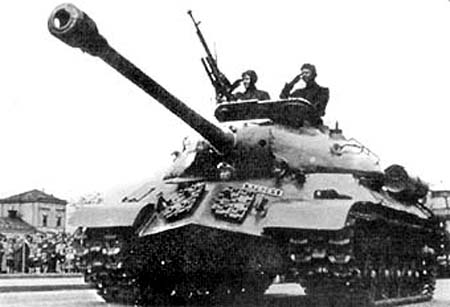
 IS-3 (1945)
IS-3 (1945)
 2311 built. Developed from 1944 but only introduced at the very end of the war this third gen. heavy tank called "Spike" and introducing the new hemispheric cast turret has a completely revised armor but the same 122mm gun as for the IS-2, and served until the 1960s.
2311 built. Developed from 1944 but only introduced at the very end of the war this third gen. heavy tank called "Spike" and introducing the new hemispheric cast turret has a completely revised armor but the same 122mm gun as for the IS-2, and served until the 1960s.
 IS-4 (1947)
IS-4 (1947)

250 built. The IS-4 was a less ambitious design, an alternative to the IS-3. The hull was still inspired by the T-34 simple design (although with a faceted front) and the turret was modeled after the T-34/85 one. Production was stopped because of poor mobility and its short active service was spent facing China.
IS-6 and IS-7 (1945 and 1946)
 The IS-6 prototype Object 253 tested an electrical transmission, but the project was dropped as it was prone to overheating. The Object 252 had the same design but with a modified drivetrain and conventional transmission. The IS-7 (3 prototypes) was developed in 1948 with a 130 mm S-70 gun and autoloader in a hemispheric turret. At 68 tons it was the heaviest of the serie. The driver was hydraulically assisted, and it had a brand new 1050-horsepower engine under his feets capable to bring this tank to 60 km/h. The armor was proof against 130mm rounds. Although very promising it was however never produced.
The IS-6 prototype Object 253 tested an electrical transmission, but the project was dropped as it was prone to overheating. The Object 252 had the same design but with a modified drivetrain and conventional transmission. The IS-7 (3 prototypes) was developed in 1948 with a 130 mm S-70 gun and autoloader in a hemispheric turret. At 68 tons it was the heaviest of the serie. The driver was hydraulically assisted, and it had a brand new 1050-horsepower engine under his feets capable to bring this tank to 60 km/h. The armor was proof against 130mm rounds. Although very promising it was however never produced.
 The T-10 (1959)
The T-10 (1959)
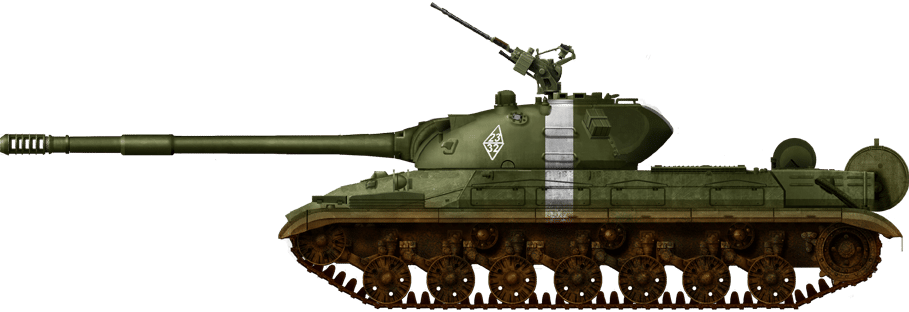
1439 built. Last heavy tank to be developed from 1950, the IS-8 had a longer hull, a relatively conventional turret but a revised armor new 120 mm gun with fume extractor, and a new diesel engine. With the death of Stalin it was renamed T-10. At 52 tons, this tank was produced until 1966. The T-10/T-10M was the last of the heavy tank breed that never proved their usefulness since the emergence of far cheaper and faster tanks like the T-54/55s and especially the T-62.
Mediums & MBTs: From the T-54 to the T-80
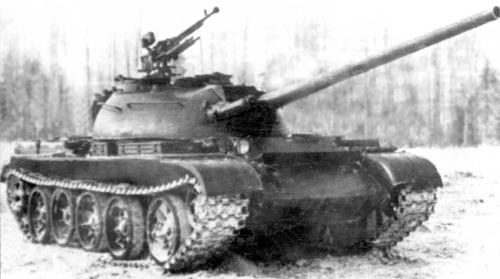
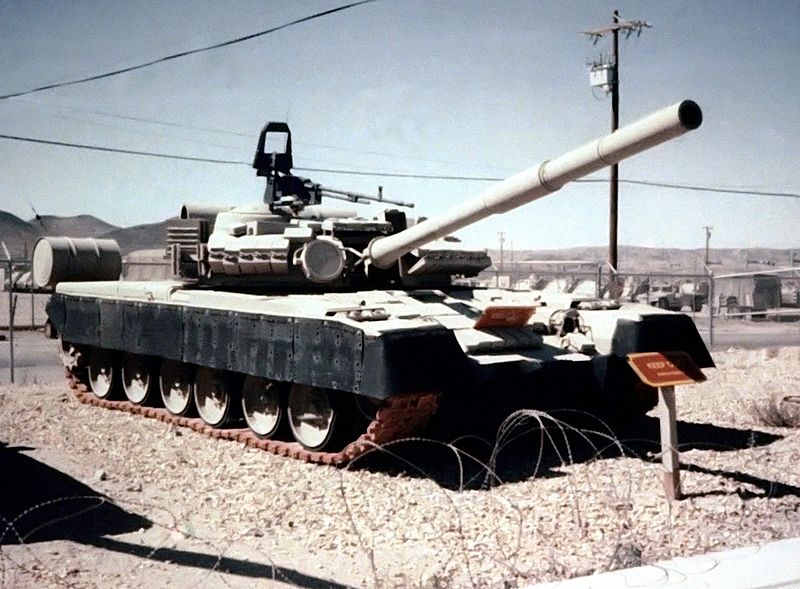
Two extremes of the entire MBT lineage of the Warsaw pact: The 1950s, 1st generation T-54, and at the opposite, the third generation T-80. The T-54/55 and T-62s were relatively cheap and low-tech, mass-produced tanks, which were gradually discredited on the middle eastern and 1991/2003 Iraqi theater. The T-64 was a breed apart, a brave attempt to create second generation MBT right into the 1960s, which ended with the creation on a way in between with the T-72.
This was the true successor to the earlier types, well modernized in between, but also a true second generation MBT. The T-80 was the successor of the high tech T-64 and was mixed with the T-72M to create the T-90 just when Soviet Union collapsed. At that time, although these models seemed closely related, lessons learned about the soviet quantity over quality dogma, the balance gradually and surely leaning toward the second...
 T-54 (1949)
T-54 (1949)
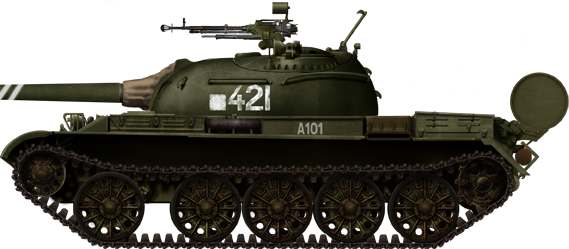
35,000 built. First medium tank of the cold war and a very famous one, it was still driven by the famous vision of "quantity has a quality in itself". A simple and rugged the T-34 was this first MBT was developed through the T-44, and its entirely revised hull, but showcased a brand new hemispherical cast turret and 100 mm gun. When introduced in 1948 it was superior to anything in the west. Through modernization, it is still in service worldwide and had an extraordinarily active life.
 T-55 (1955)
T-55 (1955)
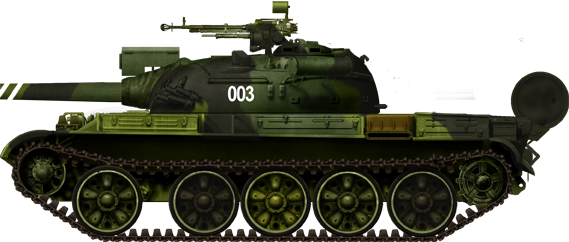
27,500 built. Basically, a modernized T-54 fitted with NBC protection and revised engine this very similar tank was also declined into multiple versions and sold to a considerable number of armies worldwide, seeing a very extensive service until today, through modernizations and conversions.
 T-62 (1961)
T-62 (1961)

22,700 built. The T-62 was an attempt to upgrade the main armament with a brand new 115mm smoothbore cannon and autoloader, and a stretched-out hull. However the new design had several issues (poor accuracy, faulty automatic ejector) which prevented its large adoption on the international market.
 T-64 (1964)
T-64 (1964)

12,000 built. The T-64 was a brand new design and leap forward, this very advanced tank was long into service and remained an "elite" MBT that suffered numerous delays and teething problems after its introduction. It introduced a new sophisticated FCS, new suspensions, new ultra-compact engine, new D-81T 125 mm smoothbore gun with entirely revised autoloader. However it never really made it on the export market as the T-72 was chosen instead.
 T-72 (1973)
T-72 (1973)

25,000 built. If the T-62 and T-64 never made it to the export market, the T-72 did and replaced in practice the numerous T-54/55s in service worldwide. It was derived from the T-64 and other alternative designs but was much simplified for mass-production and imposed itself inside the Warsaw Pact, also spawning lots of derivatives or licence-built version. Still widely used worldwide. One of its versions was derived into the actual Russian MBT, the T-90.
 T-80 (1976)
T-80 (1976)
 5400 built as of 2005. The T-80 was a successor to the T-64, using the same basis. Most notably, it was the first MBT produced in any numbers to be fitted with a gas turbine for propulsion. It is now one of the main Russian MBTs in service with 3000 maintained active and 1800 in reserve, about 300 in Ukraine. Great commonality with the locally-produced T-64 also help for modernizations. The T-80 despite its high price tag was also a moderate export success with ten operators.
5400 built as of 2005. The T-80 was a successor to the T-64, using the same basis. Most notably, it was the first MBT produced in any numbers to be fitted with a gas turbine for propulsion. It is now one of the main Russian MBTs in service with 3000 maintained active and 1800 in reserve, about 300 in Ukraine. Great commonality with the locally-produced T-64 also help for modernizations. The T-80 despite its high price tag was also a moderate export success with ten operators.
Light tanks
The PT-76 was the most common of the soviet light tank force, fully amphibious, it also formed the basis for many derivatives (APCs, command vehicles, SPAAGs, missiles launchers...). On the other hand, no less than four types of airborne vehicles were produced to match the requirement of paratroopers support on the field. PT-76 (1952)
PT-76 (1952)
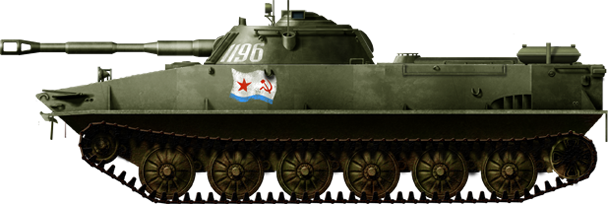
12,000 built. Amphibious tank. Designed in 1950 as a reconnaissance tank, it was light enough and had the right buoyancy to cross large rivers and lakes as well as assault by sea. Armed with the low-velocity 75mm gun and about 2000 were exported. At least a dozen known variants.
 ASU-57 (1951)
ASU-57 (1951)

500 built. A tankette tailored to be airdropped. Served only with the VDV (paratroopers corps), and armed with the Ch-51 57mm main gun. Retired and replaced by the ASU-85.
 ASU-85 (1959)
ASU-85 (1959)

The replacement for the ASU-57, still airborne SPG this time upgraded with an fully armoured roof and better 85mm high velocity gun capable to engage most Western Tanks. It was only used until the introduction of the BMD-1 which had the advantage to carry troops inside the vehicle (albeit a few).
Infantry Fighting Vehicles
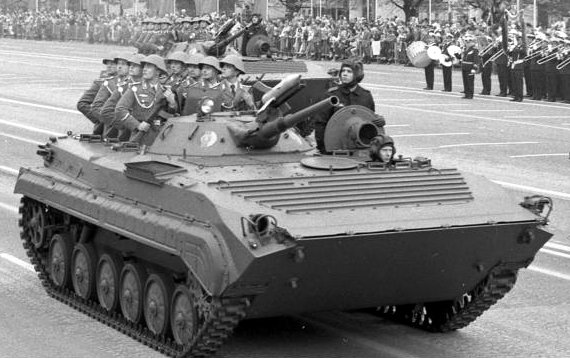
The BMP family literally from "Infantry Fighting vehicle", is probably the most common type of IFVs ever to be found in the world, with a total of 50,000 vehicles, to compare with the 6,500 Bradley ever manufactured.
 BMP-1 (1966)
BMP-1 (1966)

20,000+ built. The most produced and famous IFV, largely exported, derived and produced under license. Could carry 3 crew plus 8 infantry, armed with a 73mm low velocity gun, ATGMs and KPVT light machine guns. However operations in Afghanistan and Chechnya showed its limitations in urban combat, low protection against mines and RPGs.
 BMP-2 (1980)
BMP-2 (1980)
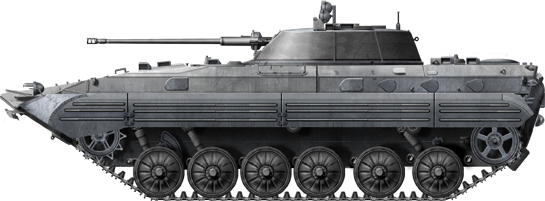
20,000+ BMP-2 built. Production records are difficult to established due to an intense license production (Czechoslovakia, India, Bulgaria), exports and conversions. Revealed in 1978 but only entering service in 1980 it was relatively similar to the BMP-1 but armed with a 30mm autocannon instead and eliminated all the drawbacks of its predecessor.
 BMP-3 (1987)
BMP-3 (1987)
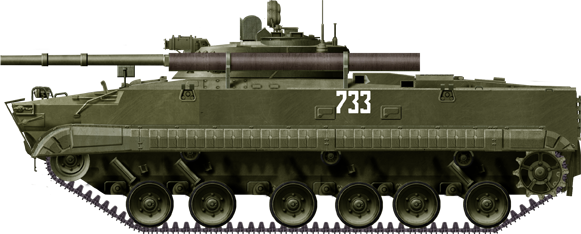
2000+ BMP-3 built. Developed in the Soviet era, it entered service just before the collapse of USSR. Therefore only a limited numbers were built, declined into 17 variants (Russia alone) and exported to 11 countries. The great novelty was the use of a 100mm gun/launcher 2A70 capable of delivering ATGMs (internal reload). It was coupled to a 30 mm autocannon 2A72 and three machine guns, quite a firepower for an augmented troop transport.
 BMD-1 (1969)
BMD-1 (1969)
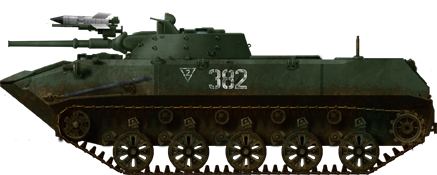
3000 built. First airborne IFV designed as such. A good package helped by the size of the new generation Soviet carrier planes and combining a troop compartment, low velocity 73mm gun, two LMGs and two ATGMs (with more in stock) intended to deal with tanks (the gun was more designed to deal with infantry and light vehicles or obstacles).
 BMD-2 (1985)
BMD-2 (1985)
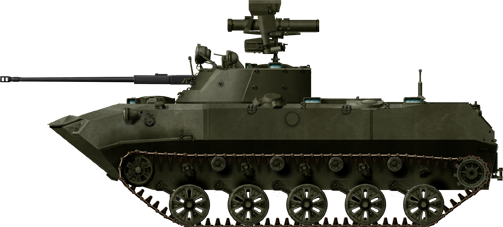
Replacement for the BMD-1 equipped with the 30 mm 2A42 multi-purpose autocannon, slightly larger according to the upgrade of Soviet carrier aircraft in capabilities. It was designed to replace the BMD-1 but failed to do so completely because of a production curtailed in 1991 with the Soviet economy collapse. It could be transported by the An-12, An-22, Il-76, An-124 and Mi-6, Mi-26 helicopters which like its predecessor, which gave it a fairly large array of tactical flexibility. It was superseded by the BMD-3 developed from the mid-1980s but only delivered from 1990 and an overall larger and more capable vehicle.
Armoured personal carriers
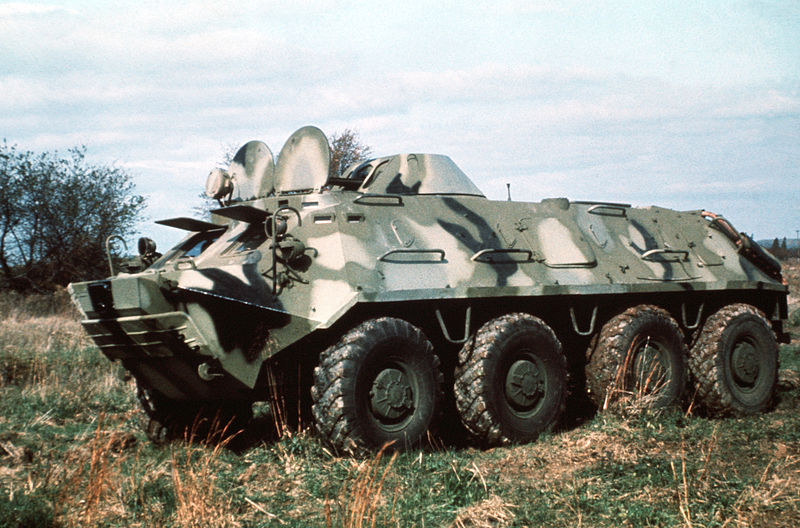
The BTR-40 was a 4x4 successor to the light wartime BA-64, and the BTR-152 was inspired by ww2 vehicles like the M3 half track. But the bulk of armoured troop transports was provided by the 8x8 Bronetransporters 60, 70 and 80, which were amphibious, NBC proven, with a better off-road motricity and also a cumulated 50,000 vehicles in all (real production figures are still ellusive). The smaller BRDMs were 4x4 well armed reconnaissance vehicles. The BMP-50 is the only tracked vehicle of the lot.
 BTR-40 (1950)
BTR-40 (1950)
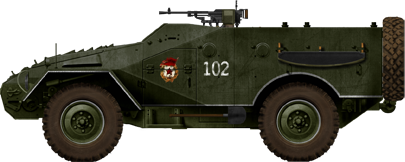
8500 built. Postwar APC, designed as a replacement for the mass-produced 4x4 BA-64 reconnaissance vehicle which was already used often as an APC despite its small size. The BTR-40 was much larger and had many improvements but was still open-top an, therefore, had no NBC protection (but for some specialized vehicles).
 BTR-152 (1949)
BTR-152 (1949)
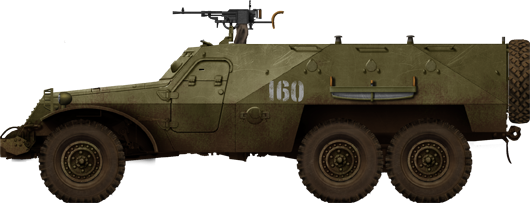
15,000 built. First Soviet dedicated Postwar APC (before that soviet troops only knew "tank desant"), this 6x6 wheeled vehicle recalled American and German ww2 half-tracks. A simple all-wheeled configuration was preferred with a central tyre inflation system that allowed to deflate tyres (and therefore create more contact surface) on soft grounds. Open top and therefore not NBC protected but for specialized variant with hard-top.
 BTR-50 (1952)
BTR-50 (1952)
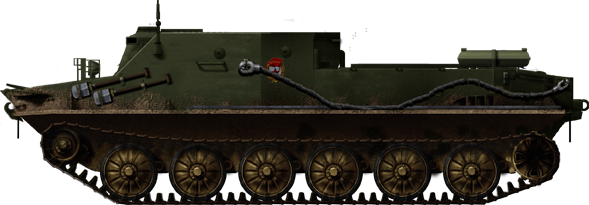
6,000 built. Tracked amphibious APC, although still not NBC protected. It was delivered to 20+ countries and declined into six main variants.
 BTR-D (1985)
BTR-D (1985)
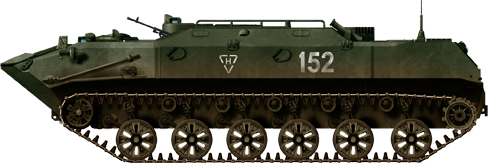
The BTR-D was a derivative of the BMD-1, the idea was to have an airborne APC, rather than an IFV that can only carry a symbolic crew and troops. It was introduced in 1974 and known by the west in 1979. In basic configuration, this 8.5 tons tracked APC (which shared a lengthened chassis with the MBD) only had a light PKT MG, but could carry a platoon, 10 troops, able to fire through portholes and roof hatches, yet protected against small arms fire overall. The front was even thicker by its slanted shape than on the BMD1/2. 11 versions has been done (production stopped in the 1990s with over 1000 delivered, kept by successors states), the last of which was the artillery support variant 2S9 "Nona".
 BTR-60 (1960)
BTR-60 (1960)
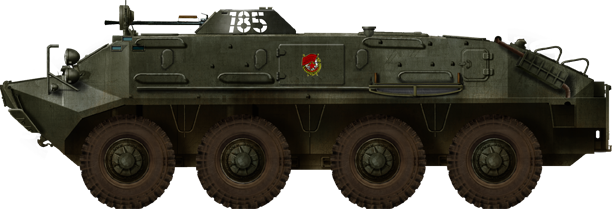
25,000 built. The proverbial Soviet wheeled APC, declined into dozens of specialized variants and largely exported. It was NBC-protected (on later variants) and amphibious. However its compartimentation with central escape hatches (rather than a rear door) made it difficult for the troops to operate in safety.
 BTR-70 (1972)
BTR-70 (1972)

5000 BTR-70 built. Less common but still well exported, this vehicle was given a heavier armament and more powerful engine. At least 30 known variants, Soviet or local, like the Romanian TAB-77.
 BTR-80 (1986)
BTR-80 (1986)
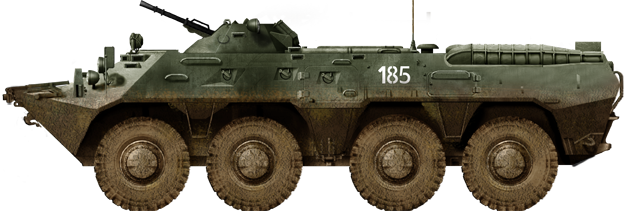
5000 BTR-80 built. Last soviet evolution of the type, with several modifications but the same armament, later declined into the BTR-90 and BTR-82 IFVs. It is the base for several Ukrainian sub-variants.
 BRDM-1 (1957)
BRDM-1 (1957)
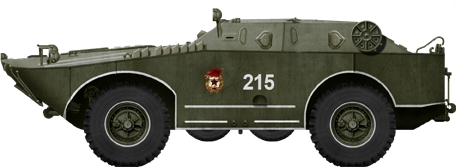
10,000 built. Amphibious reconnaissance vehicle. Also declined as a tank-hunter and many other variants. Well exported, mostly in Africa (about 50 countries).
 BRDM-2 (1962)
BRDM-2 (1962)
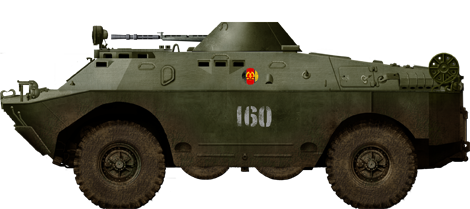
Modernized version, with a heavier armament and many more versions despite a lower production.
Self-propelled artillery
 2S1 Gvodizka (1970)
2S1 Gvodizka (1970)
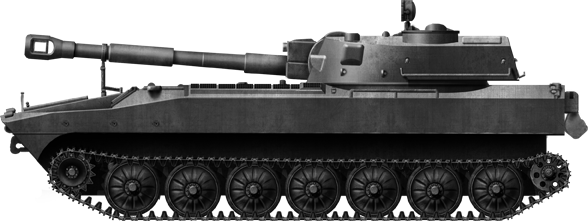 The 2S1 Gvozdika (1970) was the most current Soviet self propelled artillery during the cold war, a vehicle equipped with a 122 mm gun howitzer in turret, very low compared to its Western equivalents. It was delivered in the tens of thousands until 1991 to fill the organic rôle of mobile artillery into each motorized rifle division or Tank division (72 or 36 respectively per unit), and was largely exported and also produced under licence by Poland, Romania, Iran, and Bulgaria.
The 2S1 Gvozdika (1970) was the most current Soviet self propelled artillery during the cold war, a vehicle equipped with a 122 mm gun howitzer in turret, very low compared to its Western equivalents. It was delivered in the tens of thousands until 1991 to fill the organic rôle of mobile artillery into each motorized rifle division or Tank division (72 or 36 respectively per unit), and was largely exported and also produced under licence by Poland, Romania, Iran, and Bulgaria.
 2S3 "Akatsiya" (1971)
2S3 "Akatsiya" (1971)

After the 2S1, people assume there was a 2S2, but it remained as a paper project and the program jumped directly to the next 2S3 (from nine models of Soviet self-propelled-guns during the cold war alone. The 2S3 "Akatsiya" ("acacia", Soviet SPGs were traditionally namd after flowers) could be summarized as the Soviet response to the American M109, which developed started in 1967 and the prototype SO-152 tested in 1968, entering service in 1971. Armed with a 152.4 mm D-22 howitzer in a new larger turret compared to the 2S1, it was lightly armored (30 mm max) and a tailored chassis, engine, transmission and drivetrain that were reused for many other vehicles. Declined into six variants it was exported to 17 countries, some former Soviet republics after the USSR fall. Mass production ended in 1993, with around 3,500 vehicles (900+ active, 1600 in storage for Russia alone, 500 for Ukraine, etc.). It was a reliable vehicle but past 2000s, outranged by all modern Western SPGs.
 2S4 "Tyulpan" (1972)
2S4 "Tyulpan" (1972)
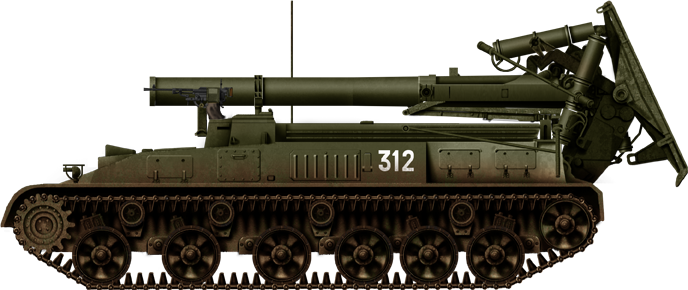
The 2S4 "Tulip" was developed in parallel to the 2S3, on the same chassis, but fitted with a 240mm mortar mortar instead, trading range for punch. When deployed, the mortar mount unit was to be pivoted to the rear, the base plate anchored in the ground, to be recoil-absorbing. The lenght of the tube and size of the rounds preventing all manual feed, an autoloader was used. Approximatively only 588 2S4 were built, which mortar could deliver HE rounds at 9500 m, and up to 20,000 with extended-range ammunitions. It was known by NATO in 1975 and production ran from 1969 to 1988. Outside USSR, only Czechoslovakia and Syria used it. They are now under modernization for the Russian Army.
 2S5 "Giatsint" (1972)
2S5 "Giatsint" (1972)

The "Hyacinth" was another SPG based on the same chassis, which left the crew unprotected. It was developed in 1967–1974, and produced from 1976 to 1991 to replaced the towed 130mm M46 field guns, replaced by this self-propelled 2A36 152 mm gun (5.98 in) which can reach a target at 28 km, up to 40 with assisted projectiles. Production was about 1,100 given the exports and listed vehicles, either in service or storage in Russia. Outside Russia, it is used by Ethiopia, Finland, Belarus, and Ukraine.
 2S9 "Nona" (1985)
2S9 "Nona" (1985)

NONA meant "Newest Ordnance of Ground Artillery". Developed from 1974 it was a way to provide to the VDVs (airborne divisions) a lighT-weight self-propelled, air-droppable 120 mm gun-mortar. It entered service in 1981, based on the S-120 aluminium hull derived from the BTR-D armoured personnel carrier (which had an extra wheeltrain). This 8.7 tons 120 mm mortar 2S9 Nona and Nona-S was used at least in two conflicts, the Syrian Civil War and the war in Donbass. Production is unknown but probably over 1000. It was also used by Syria, Kazakhstan, Ukraine and Venezuela. The BTR-80 was converted with the same system as the 2S23 Nona-SVK. There was even a tower versions called 2B16 Nona-K.
 ZSU-23-4-Shilka (1962)
ZSU-23-4-Shilka (1962)
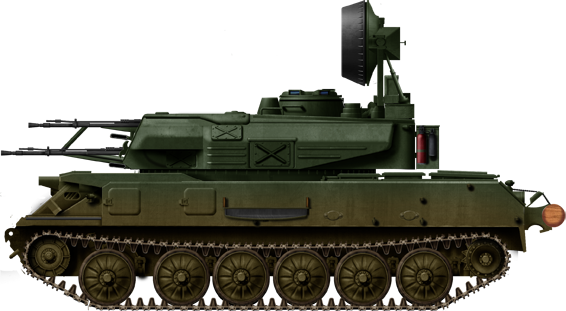
The Zenitnaya Samokhodnaya Ustanovka 23 (mm) -4 (tubes) "Shilka" because of the Shilka River was really the first, modern mass-distributed SPAAG of the cold war. It was a replacement for the 1950s "Sparka" or "pair", the ZSU-57-2, a more crude weapons systems. The new weapons system was to correct any deficiencies of the previous vehicles, like the innacuracy, lack of radar, and impossibility to fire on the move or the small supply of ammunitions. Developed from 1957 to 1962 it really entered service with much more than the USSR and Wardsaw Pact, but the 6500 allegedly built by Mytishchi Engineering Works (MMZ) until 1982 served with more than 40 operators around the world. There were a dozen of variants, including modernizations like the 4M of 1973 or the Russian ZSU-23-4M5 augmented with MANPADS and new electronics, radar and digital calculators in 1999, mostly as an upgrade kit for export. It has been replaced since by the "Tunguska" in the Russian arsenal.
Soviet cold war related links
Soviet armour (generic) on Wikipedia Google Book - Soviet Military Operational Art of Deep BattleAll types of artillery and utility tractors

Cold War Tanks


































Cold war tanks posters

Cold War Main Battle Tanks

Cold War Soviet Army
